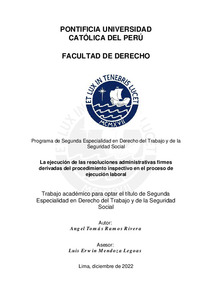La ejecución de las resoluciones administrativas firmes derivadas del procedimiento inspectivo en el proceso de ejecución laboral
Abstract
Conforme a la Ley Procesal del Trabajo, las resoluciones administrativas firmes
emitidas por la autoridad de trabajo en un procedimiento inspectivo sancionador
constituyen títulos ejecutivos; sin embargo, el beneficiario de la obligación prefiere
utilizarlo como medio probatorio en un proceso ordinario o abreviado y no recurrir
directamente a su ejecución en un proceso ejecutivo laboral.
Esta situación origina que, en sede judicial, se vuelva a analizar un tema que ya fue
determinado por el sistema inspectivo de trabajo, lo que trae consigo que existan
discrepancias de criterios entre lo resuelto por la autoridad administrativa y el órgano
jurisdiccional correspondiente, deslegitimando el sistema de protección de los derechos
del trabajador.
Así, el presente trabajo tiene como objetivo estudiar si dichas resoluciones cumplen con
los requisitos propios de un título ejecutivo, así como los problemas que se presentan en
la emisión de dichas resoluciones, en especial, cuando en forma paralela se inicia un
proceso judicial por similares hechos, así como en la ejecución de la resolución,
brindando una respuesta a las controversias que pueden suscitarse en esta etapa.
Luego del análisis correspondiente, podemos indicar que existen problemas con la
determinación de la obligación que se reconoce en una resolución administrativa firme,
lo que aunado a los diversos recursos legales que puede plantear el obligado, dificulta su
ejecución en un proceso judicial. Pursuant to the Labor Procedure Law, the firm administrative resolutions issued by the
labor authority in a sanctioning inspection procedure constitute executive titles;
however, the beneficiary of the obligation prefers to use it as evidence in an ordinary or
abbreviated process and not resort directly to its execution in a labor executive process.
This situation causes that, in judicial headquarters, an issue that was already determined
by the labor inspection system is reanalyzed, which entails that there are discrepancies
in criteria between what was resolved by the administrative authority and the
corresponding court, delegitimizing the worker rights protection system.
Thus, the objective of this work is to study whether these resolutions meet the
requirements of an executive title, as well as the problems that arise in the issuance of
said resolutions, especially when a judicial process is initiated in parallel. for similar
events, as well as in the execution of the resolution, providing a response to the
controversies that may arise at this stage.
After the corresponding analysis, we can indicate that there are problems with the
determination of the obligation that is recognized in a firm administrative resolution,
which, together with the various legal resources that the obligor can raise, makes it
difficult to execute in a judicial process.
Temas
Procedimiento laboral--Perú
Inspección de trabajo--Perú
Procedimiento administrativo--Perú
Inspección de trabajo--Perú
Procedimiento administrativo--Perú
Para optar el título de
Segunda Especialidad en Derecho del Trabajo y de la Seguridad Social
Collections
The following license files are associated with this item:






